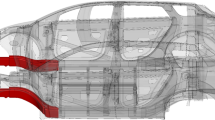Abstract
The aim ofthis study is to find the optimal structural geometry ofthe front crash member of a car of minimal mass that optimally satisfies all operational conditions. The mechanical domains that have been considered are crash, acoustic (dynamic) and static. They are summed up by 9 objective functions, resulting in a 10-objective optimization problem. However, this problem is further turned into minimizing the mass while maximizing the internal energy (crash objective), subject to constraints on the 8 objectives that arise from the acoustic and static domains. The dimension of the objective space of this constrained problem is much lower than that of the original 10-objective problem. This significantly reduces convergence time, while decreasing decision making efforts among solutions obtained though pareto-based multiobjective optimization.
Nevertheless, since the computation of the structural responses is based on a very time-consuming FEM crash analysis, direct computation of the fitness within an evolutionary algorithm is impossible: The response of car front members is computed using an approximative evaluation that had been identified during the BE96-3046 European project (CE)2: Computer Experiments for Concurrent Engineering.
Thanks to this approximation, very good results are obtained in a reasonable time using a Pareto elitist evolutionary algorithm based on NSGA-II ideas, combined with an infeasibility objective approach for constraint handling.
Access this chapter
Tax calculation will be finalised at checkout
Purchases are for personal use only
Preview
Unable to display preview. Download preview PDF.
Similar content being viewed by others
References
Bates, R., Bosio, T., Fontana, R. and al. (2000) Computer Experiments for Concurrent Engineering. European Congress on Computational Methods in Applied Sciences and Engineering
Corne, D. W., Knowles, J. D. and Oates, M. J. (2000). The Pareto Envelope-Based Selection Algorithm for Multiobjective Optimization. In Schoenauer et al. (Eds.) Parallel Problem Solving from Nature (PPSN VI), pages 839–848. Springer Verlag LNCS Vol. 1917.
Deb, K. (2001). Multi-Objective Optimization Using Evolutionary Algorithms. John Wiley.
Deb, K., Agrawal, S., Pratap, A. and Meyarivan, T. (2000). A Fast Elitist Nondominated Sorting Genetic Algorithm for Multiobjective Optimization: NSGA-II. In Schoenauer et al. (Eds.) Parallel Problem Solving from Nature (PPSN VI), pages 849–858. Springer Verlag LNCS Vol. 1917.
Fonseca, C. M. and Fleming, P. J. (1998) Multiobjective Optimization and Multiple Constraint Handling with Evolutionary Algorithms— Part 1: A Unified Formulation. IEEE Transactions on Systems and Cybernetics—Part A: Systems and Humans. 28 No.1, pages 26–37.
Grefenstette, J. J. and Fitzpatrick J.M. (1985). Genetic search and approximate function evaluation. In Grefenstette, J. J. (Eds), Proceedings of the 1 stInternational Conference on Genetic Algorithms, pages 160–168. Morgan Kaufman
Grefenstette, J. J. (1995). Predictive Models Using Fitness Distributions of Genetic Operators, In L. Darrell Whitley and Michael D. Vose (Eds), Foundations of Genetic Algorithms 3, pp. 139–162. Morgan Kaufmann.
Goldberg, D.E. and Richardson, J. (1987). Genetic Algorithms with sharing for multi-modal function optimization. In Grefenstette, J.J. (Eds), Proceedings of 2nd ICGA, pages 41–49, Lawrence Erlbaum Associates.
Michalewicz, Z, and Schoenauer, M. (1996). Evolutionary Algorithms for Constrained Parameter Optimization Problems. Evolutionary Computation, 4(1):1–32.
Mosetti, G. and Poloni C. (1995). Aerodynamic Shape Optimization by means of Hybrid Genetic Algorithms, In 3rd International Congress on Industrial and APplied Mathematics, Hamburg.
Obayashi, S. (1997). Pareto Genetic Algorithm for Aerodynamic Design Using the Navier-Stokes Equations. In Quadraglia, D., Périaux, J., Poloni C., and Winter G. (Eds) Genetic Algorithms and Evolution Strategies in Engineering and Computer Sciences, pages 245–266. John Wiley.
Poloni, C. and Pediroda V. (1997). GA coupled with computationaly expensive simulations: tools to iprove efficiency, In Quadraglia, D., Périaux, J., Poloni C., and Winter G. (Eds) Genetic Algorithms and Evolution Strategies in Engineering and Computer Sciences, pages 267–288. John Wiley.
Ratle, A. and Berry, A. (1998). La réduction du rayonnement acoustique des structures par un design optimal utilisant un algorithme génétique. Actes du 66ième congrès de l’Acfas, Montreal.
Sacks, J. W., Welsh, T. Mitchell and Wynn, H. (1989). Design and Analysis of Computer Experiments. Statistical Science 4 (4).
Sbalzarini, I. F., Muller, S., Koumoutsakos, P. (2001). Michrochannel Optimization Using Multiobjective Evolution Stratagies. In [18].
Wright, J. and Loosemore, H. (2001). An Infeasibility Objective for Use in Constrained Pareto Optimization. In [18].
Zitzler, E., Deb, K. and Thiele, L. (2000). Comparison of Multiob jective Evolutionary Algorithms: Empirical Results. Evolutionary Computation, 8(2): 173–195.
Zitzler, E., Deb, K., Thiele, L., Coello Coello, C. A., and Corne, D. editors (2000). Evolutionary Multi-Criterion Optimization (EMO 2001), Springer Verlag, LNCS series Vol. 1993.
Author information
Authors and Affiliations
Editor information
Editors and Affiliations
Rights and permissions
Copyright information
© 2002 Springer-VerlagBerlin Heidelberg
About this paper
Cite this paper
Rudenko, O., Schoenauer, M., Bosio, T., Fontana, R. (2002). A Multiobjective Evolutionary Algorithm for Car Front End Design. In: Collet, P., Fonlupt, C., Hao, JK., Lutton, E., Schoenauer, M. (eds) Artificial Evolution. EA 2001. Lecture Notes in Computer Science, vol 2310. Springer, Berlin, Heidelberg. https://doi.org/10.1007/3-540-46033-0_17
Download citation
DOI: https://doi.org/10.1007/3-540-46033-0_17
Published:
Publisher Name: Springer, Berlin, Heidelberg
Print ISBN: 978-3-540-43544-0
Online ISBN: 978-3-540-46033-6
eBook Packages: Springer Book Archive




